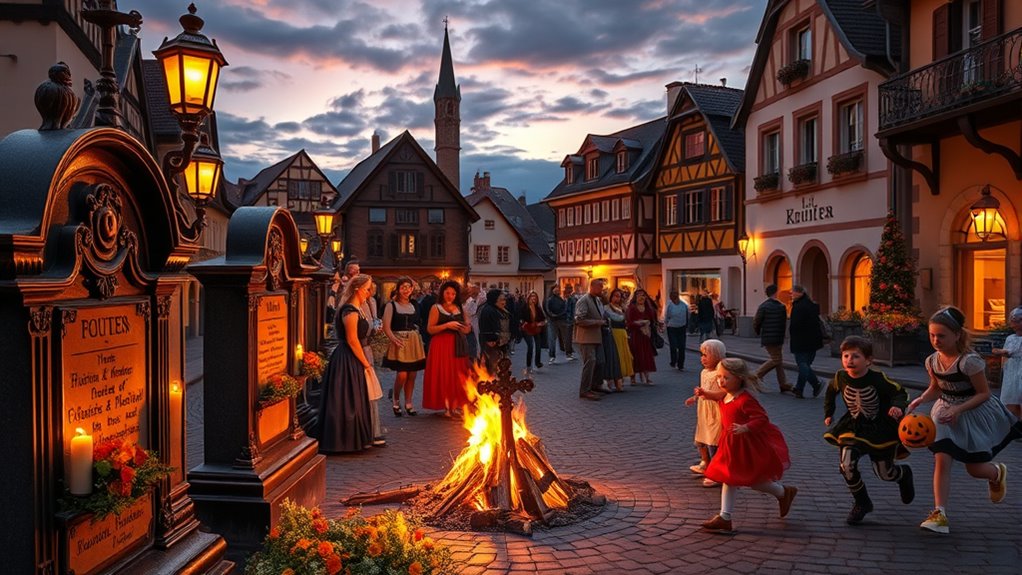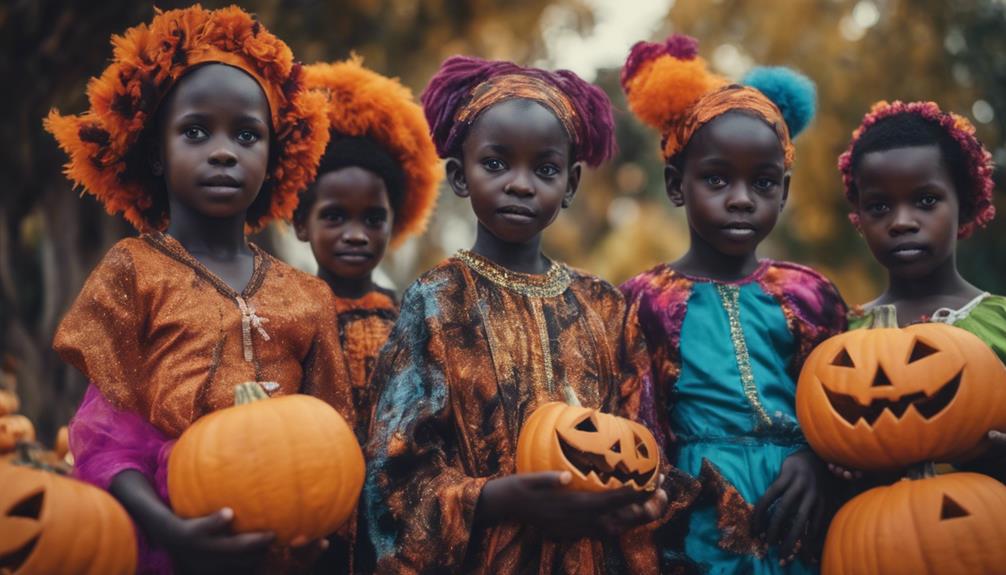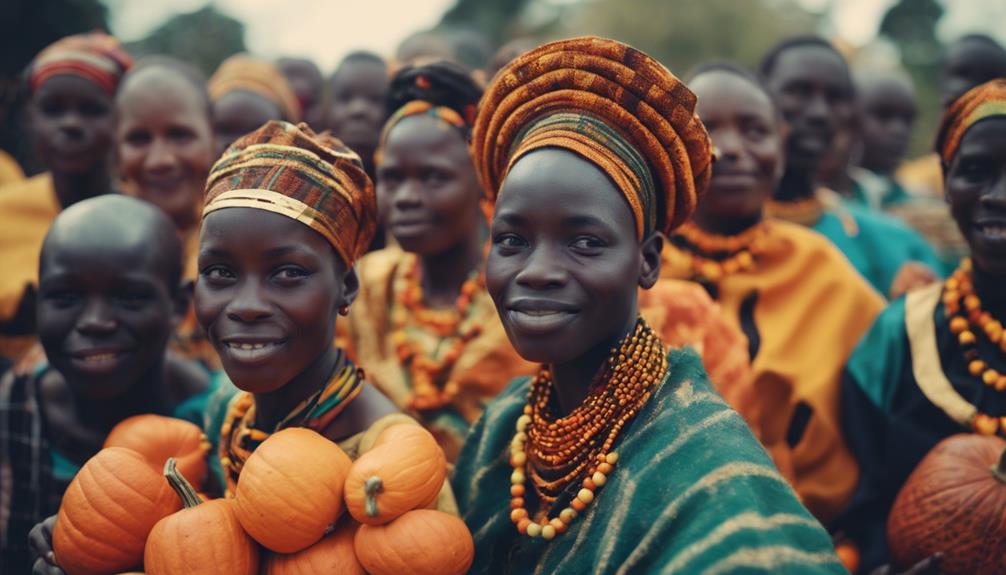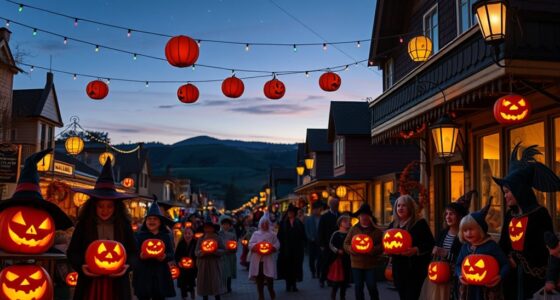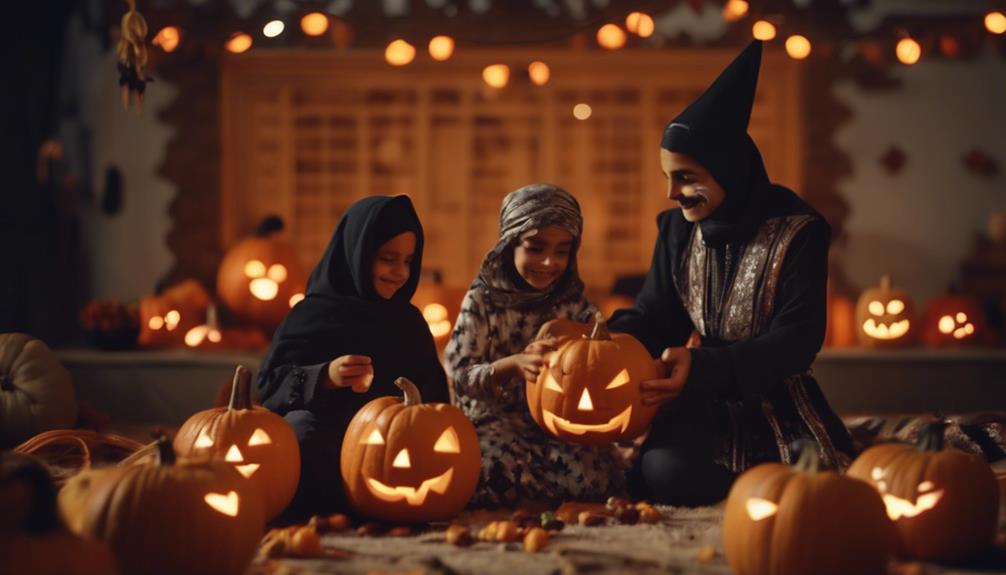In Austria, All Souls’ Day is a somber event focused on honoring and remembering loved ones who have passed away, with traditions like visiting cemeteries, tending graves, and lighting candles. In contrast, Halloween is more festive and playful, involving costumes, trick-or-treating, and spooky decorations inspired by Celtic and American influences. These customs reflect their different cultural roots and purposes. Keep exploring to discover how these traditions continue to shape their unique celebrations.
Key Takeaways
- Austria’s All Souls’ Day is a solemn occasion focused on cemetery visits, lighting candles, and honoring deceased loved ones.
- Halloween emphasizes costumes, trick-or-treating, and spooky decorations, influenced by Celtic and American entertainment traditions.
- Austrian customs foster reflection, with families tending graves and leaving flowers like chrysanthemums to remember ancestors.
- Halloween is primarily a festive, entertainment-driven event with playful and spooky themes.
- The two traditions reflect different cultural values: spiritual remembrance versus festive celebration.
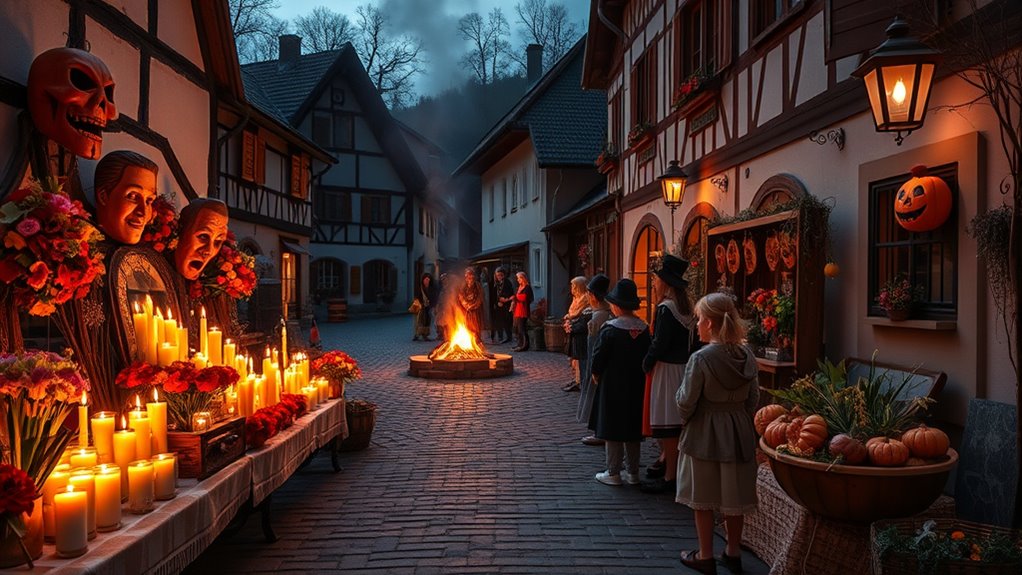
As Halloween grows more popular worldwide, Austria maintains its own unique traditions for honoring the departed during All Souls’ Day. You might notice that, unlike the Halloween festivities filled with costumes, trick-or-treating, and spooky decorations, Austria’s customs are rooted deeply in historical origins and cultural differences that emphasize remembrance and respect. The historical origins of Austria’s All Souls’ Day date back centuries, influenced by Catholic traditions and local folklore. This day, observed on November 2nd, centers around the idea of commemorating deceased loved ones through visits to cemeteries, leaving flowers, and lighting candles. These practices serve as a quiet, reflective act of remembrance, contrasting sharply with Halloween’s festive and sometimes mischievous spirit.
In Austria, the cultural differences shape how these days are perceived and celebrated. While Halloween has become increasingly popular among younger generations, many Austrians still see All Souls’ Day as a solemn occasion. You’ll notice that cemeteries fill with families who come to tend to graves, placing chrysanthemums and lighting candles that flicker softly in the dusk. These candles symbolize hope and remembrance, illuminating the night in a way that feels sacred rather than playful. The emphasis on honoring ancestors reflects a cultural respect for family history and spiritual connection, which remains central to Austrian customs.
Unlike Halloween’s emphasis on costumes and spooky themes, Austria’s All Souls’ Day focuses on quiet observation. You might see processions or hear hymns sung in church services, embodying a sense of community and reverence. The traditions highlight a collective acknowledgment of mortality and the importance of keeping loved ones’ memories alive. This cultural approach fosters a reflective atmosphere, where the focus is on personal and communal mourning rather than entertainment.
Additionally, the historical origins of these customs reveal how Austria’s religious and cultural landscape has shaped its approach to death and remembrance. Halloween’s roots trace back to Celtic harvest festivals and later influenced by American pop culture, making it more entertainment-driven. Austria’s All Souls’ Day, however, stems from centuries-old Catholic practices that emphasize spiritual reflection and filial piety. As a result, the two observances serve different purposes: one as a fun, spooky celebration, and the other as a respectful, contemplative tribute to those who have passed. Understanding these differences helps you appreciate how traditions evolve and adapt, yet remain rooted in their unique cultural and historical contexts. Cultural significance plays a crucial role in shaping how each day is observed and experienced by communities.
Frequently Asked Questions
How Did Austria’s All Souls’ Customs Originate Historically?
You’re curious about how Austria’s All Souls’ customs originated. Historically, these customs have deep roots in Catholic traditions, influenced by cultural practices from neighboring regions. You’ll find that they celebrate and honor departed loved ones through rituals that date back centuries, blending local beliefs with religious observances. These practices reflect Austria’s rich cultural influences, emphasizing remembrance and spiritual connection, and have evolved over time while maintaining their historical and cultural significance.
Are There Regional Differences in Austria’s All Souls’ Celebrations?
Imagine a tapestry woven with countless threads; each region adds its unique color. You’ll find regional variations in Austria’s All Souls’ celebrations, where local traditions shape how communities honor the departed. In some areas, processions and candlelit graves dominate, while others focus on family gatherings and storytelling. These regional differences enrich the customs, making Austria’s All Souls’ observances a vibrant mosaic reflecting local culture and history.
How Do Children Participate in Austria’S All Souls’ Traditions?
You participate in Austria’s All Souls’ traditions by dressing up in children’s costumes, often resembling angels or saints, to honor the departed. Kids go door-to-door, similar to trick-or-treating, where they receive candy distribution from neighbors. This lively activity allows you to connect with the community, celebrate loved ones who have passed, and enjoy sweet treats while embracing the cultural customs that make this occasion special.
What Symbols Are Commonly Associated With Austria’S All Souls’ Customs?
Imagine walking through a sea of symbols so powerful, they could stop time—soul candles flickering like tiny stars and grave decorations bursting with colors and life. In Austria’s All Souls’ customs, these symbols are everywhere, illuminating the darkness and honoring loved ones. You’ll see soul candles lighting the way, and graves decorated with flowers, ribbons, and meaningful tokens—each piece a heartfelt tribute to those who’ve passed.
How Has Austria’S All Souls’ Celebration Evolved Over Recent Decades?
You’ve seen how Austria’s All Souls’ celebration has evolved recently, blending traditional customs with modern influences. Cultural influences from neighboring countries and global trends have introduced new practices, like community events and themed activities. You might notice modern adaptations such as contemporary decorations and social media sharing, which help keep the tradition alive and relevant for younger generations, while still honoring the deep-rooted customs of remembering loved ones.
Conclusion
Understanding Austria’s All Souls’ customs versus Halloween highlights how traditions reflect cultural values. For instance, imagine a family in Vienna preserving their ancestors’ graves with fresh flowers on All Souls’ Day, emphasizing remembrance. Meanwhile, Halloween’s spooky costumes and parties might seem lighthearted but can sometimes overshadow deeper traditions. Embracing both allows you to appreciate Austria’s unique way of honoring the past while enjoying modern festivities, reminding you that blending customs can enrich your cultural experience.
